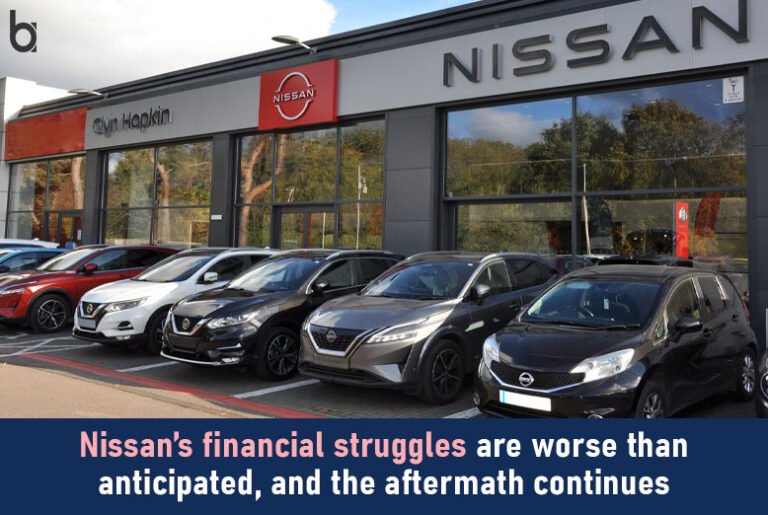Business APAC
25th April 2025
The consequences of these difficulties are still unfolding. While the entire car industry has its share of problems, Nissan seems particularly weighed down by old internal issues, strategic choices that haven’t panned out, and the difficult shift to electric vehicles. This period highlights the significant Nissan financial struggles.
Declining sales and profit warnings reveal Nissan’s deeper-seated financial struggles
Any optimism about a quick turnaround has faded with repeated downward adjustments to financial forecasts and weaker-than-hoped-for sales figures in crucial markets. What’s driving this?
- Supply Chain Headaches: Yes, semiconductor shortages and logistical snags have hit everyone, but Nissan appears to be feeling the pinch more acutely, impacting how many cars they can build and deliver.
- Tough Competition: Nissan is facing intense pressure, especially in the US and China. Traditional rivals are moving fast on EVs, and newer electric-only brands are grabbing attention and sales. Nissan’s own EV efforts, despite the early promise of the Leaf, haven’t kept pace; the Ariya, for example, hit production delays and faces strong competitors right out of the gate.
- Rising Costs: Everything costs more – raw materials, energy, shipping. This squeezes Nissan’s profit margins, making it harder to make money even as they try to cut expenses, exacerbating Nissan financial struggles.
- The Ghost of Ghosn: The drama surrounding Carlos Ghosn still lingers, impacting company culture, decision-making, and the critical partnership within the Renault-Nissan-Mitsubishi Alliance. They’ve rejigged the Alliance, but rebuilding trust and making it work smoothly again isn’t an overnight job and contributes to the ongoing Nissan financial struggles.
Nissan’s financial problems and their repercussions
This weaker performance suggests more challenges lie ahead:
- More Belt-Tightening: Expect further restructuring. This could mean more job cuts, changes to factory operations, or selling off parts of the business or car models that aren’t pulling their weight as a result of Nissan financial struggles.
- Alliance Strain: Money troubles put a strain on the Alliance. Working together on operations continues, but when one partner is struggling more than others, it complicates big joint investments, like those needed for shared EV platforms and software.
- Investment Squeeze: Less cash means less ability to pour money into the future – things like cutting-edge EV research, better batteries, and self-driving tech. This risks Nissan falling further behind bigger players who can afford to spend more, a direct consequence of Nissan financial struggles.
- Ripple Effects: When production slows and market share drops, it hits the whole network – the companies supplying parts and the dealerships selling the cars. Some of them could face their own financial difficulties.
Nissan’s financial difficulties cast a shadow of uncertainty on its future
Nissan’s leadership points to plans like “Nissan NEXT” as the path forward, but the current numbers show it’s a steep climb. The company has to juggle fierce competition, nail the complex EV transition, handle ongoing supply risks, and get its own house and its Alliance partnerships fully in order.
Until we see solid, lasting improvements in sales and profits, worries about how deep and long these Nissan financial struggles will last are likely to stick around. Nissan needs strong leadership and might have to make even tougher choices than they’ve admitted so far.
Glimpsing into Nissan’s future
Moving forward, expect Nissan to continue aggressive cost-cutting measures, which could include further restructuring like job cuts and adjustments to its manufacturing footprint. The financial strain may also complicate its relationship within the Renault-Nissan-Mitsubishi Alliance, particularly regarding joint investments in crucial EV and software development.
This investment squeeze could hinder Nissan’s ability to compete effectively in the rapidly evolving electric and autonomous vehicle landscape. Consequently, the company faces an uncertain period requiring strong leadership and potentially difficult strategic decisions to stabilize its finances and secure its long-term market position, all while navigating significant Nissan financial struggles.
Also Read: India’s Economy: Weekly Recap on Growth, Trade Tensions & Startup Revival



